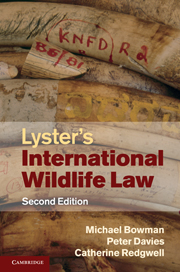Book contents
- Frontmatter
- Contents
- Foreword
- Preface
- List of abbreviations
- PART I Foundations of international wildlife law
- PART II Species regulation
- PART III Regional wildlife regulation
- PART IV Global wildlife regulation
- PART V Biological diversity: a new perspective on wildlife regulation
- PART VI Cross-sectoral issues in wildlife regulation
- 19 Wildlife and trade
- 20 Wildlife and welfare
- 21 Wildlife and pollution
- PART VII Conclusion
- Index
- References
20 - Wildlife and welfare
Published online by Cambridge University Press: 05 July 2011
- Frontmatter
- Contents
- Foreword
- Preface
- List of abbreviations
- PART I Foundations of international wildlife law
- PART II Species regulation
- PART III Regional wildlife regulation
- PART IV Global wildlife regulation
- PART V Biological diversity: a new perspective on wildlife regulation
- PART VI Cross-sectoral issues in wildlife regulation
- 19 Wildlife and trade
- 20 Wildlife and welfare
- 21 Wildlife and pollution
- PART VII Conclusion
- Index
- References
Summary
Introduction
While the principal focus of this work is upon the conservation of wildlife populations, the philosophical arguments canvassed in Chapter 3 above suggest that the intrinsic value exhibited by each autopoietic entity embraces not only the good-of-its-kind, but also the good-of-its-own: consequently, any sound ethical policy should additionally have regard to the extent to which individual organisms are permitted to flourish in accordance with their biological nature. Accordingly, insofar as such arguments merit credence in the realm of international affairs, it might be expected that a body of rules would also have emerged for the protection of individual wildlife specimens, seen not only as representatives of their kind but as legitimate objects of moral concern on their own account. The need for such measures, moreover, is plainly most acute in the case of sentient animals, whose capacity for pain and suffering generates a particularly cogent case for protection.
Formal recognition of these points may be found in the revised version of the World Conservation Strategy, Caring for the Earth, which proclaims,
Every form of life warrants respect independently of its worth to people. Human development should not threaten the integrity of nature or the survival of other species. People should treat all creatures decently, and protect them from cruelty, avoidable suffering and unnecessary killing.
- Type
- Chapter
- Information
- Lyster's International Wildlife Law , pp. 672 - 699Publisher: Cambridge University PressPrint publication year: 2010
References
- 1
- Cited by



